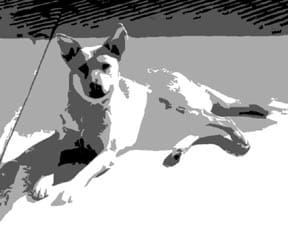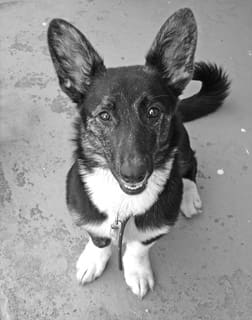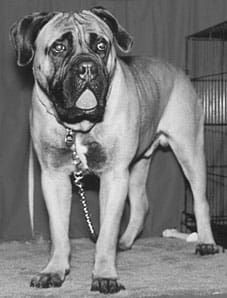Every system of medicine has something to offer, even if it’s hard to explain just what it is and how it works. I’ll admit that I’ve been subtly (I hope) resistant to discussing some alternative and complementary diagnosis techniques in WDJ, largely because I have a hard time publishing information that doesn’t make sense to me.
But seeing is believing. Once you’ve personally witnessed (as I have) a practitioner make a dead-on diagnosis and restore the health of a patient with treatments indicated by an unconventional method – well, whether it makes “sense” or not, it’s worth talking about.
I was a very skeptical journalist 13 years ago, when I was assigned to write my first article about holistic veterinary medicine. Today, I strongly believe in about 80 percent of what I then regarded as absurd. I’d characterize myself as dubious – but respectful – of about 18 percent of the rest.
If you’re an alternative medicine skeptic, I suggest you simply file this information away, in case there ever comes a day when no one else can tell you what’s wrong with your dog.
–Nancy Kerns, Editor
———-
By Shannon Wilkinson
One hundred years ago, medical practitioners had only a few tools they could use to determine the cause of their patients’ problems: visual and physical examinations, thermometers, stethoscopes, and little more.
The assemblage of veterinary diagnostic tools has expanded exponentially in the past century – particularly in the last 20 years, as technologies developed for human medicine (such as ultrasound, MRI, and CT scan) became more affordable and found their way into veterinary clinics. These tools, combined with the ability to share information about patients and treatments with other informed and experienced practitioners in “real time,” have made the field of veterinary diagnostic medicine very exciting.
The field of alternative and complementary veterinary medicine has also gained intriguing new diagnostic tools and methods over the last century. As with conventional medicine, some of these diagnostic accoutrements developed out of centuries-old medical models; some were inspired and aided by new technologies.
Why would dog owners enlist the aid of unconventional veterinary practitioners when so much amazing diagnostic science and technology can be had elsewhere? Sometimes, it’s because Western medical diagnostics failed to fully or even partly explain what is wrong with their dog, and the results of conventional treatment were incomplete, compromised, or nonexistent. Sometimes it’s because they have experienced amazing results with alternative or complementary healthcare methods. Or it may be that the unconventional approach just feels better to them.
The following are descriptions of some diagnostic techniques used by a growing number of veterinary practitioners who use alternative and/or complementary medicine. These brief snapshots are not meant to completely explain how each method works, but to introduce you to the possibility that they can work.
PHYSICAL EXAMINATIONS
A conventional veterinary examination may include looking at the dog; checking his ears, eyes, and nose; taking his temperature and pulse; and listening to his heart and lungs.
Examinations completed by a veterinarian trained in traditional Chinese medicine (TCM) are much more comprehensive, and include extensive study of the dog’s pulse and tongue. These diagnostic techniques have been an integral part of Chinese medicine for thousands of years. “The pulse and tongue provide bottom line information . . . they don’t lie,” says Cheryl Schwartz, DVM, author of Four Paws Five Directions: A Guide to Chinese Medicine for Cats and Dogs.
TCM’s pulse diagnosis: Dr. Schwartz was one of the first practitioners to adapt pulse diagnosis for veterinary medicine. She started to develop the method in the 1980s and teaches it to other veterinarians as part of her training courses in acupuncture.
Rather than simply checking the pulse in one location on the patient’s body, recording the pulse’s frequency and strength, practitioners of traditional Chinese medicine may check the pulse in as many as nine different positions, looking for up to 28 different “conditions” or “qualities.”
“For practicality in veterinary medicine the maximum is usually six positions; most practitioners only do three,” says Karen Ivin, DVM, owner of Desert Mobile Veterinary Services in Gilbert, Arizona. Dogs are not always comfortable with you palpating the pulse for long, Dr. Ivin explains.
In people, the radial pulse (found at the wrist) is normally used for observing the pulse in a leisurely manner. However, in dogs, this pulse is somewhat difficult to find; instead, the femoral artery (found on the inside of the hind leg) is used for relatively lengthy observations.
The practitioner uses three fingers to feel the dog’s pulse in three different positions along the femoral artery. Then, two levels of depth are felt in each position; the pulse felt at the surface or superficial level corresponds to the yang organs of Chinese medicine, while the deeper layer corresponds to the yin organs. By utilizing three positions and two layers on each side of the body, a trained practitioner can evaluate each of the 12 energy meridians (each relating to a different organ system) of the body.
The pulse qualities being evaluated include rate, rhythm, “shape,” and force. As she feels the pulse, Dr. Schwartz says she asks herself, “Is it large and bounding, too slow, too fast, is there enough juice?”
The qualities observed in the dog’s pulse, along with the findings from the rest of the physical examination, lead the practitioner to further investigation and treatment of specific conditions.
TCM’s tongue diagnosis: Stick out your tongue and say “Ahhh” takes on whole new meaning in traditional Chinese medicine. According to its practitioners, looking at the tongue can help determine the health of the patient’s internal organs. Dr. Schwartz describes the tongue as the “visual gateway to the interior of the body.”
According to this system, different areas on the tongue correlate to the internal organs. For instance, the tip of the tongue relates to the heart and the sides of the tongue represent the liver and gallbladder. The area just behind the tip refers to the lungs, the center of the tongue is spleen/pancreas and stomach, while the back of the tongue relates to the kidneys.
When evaluating the tongue, the practitioner looks at its color, shape, and coating. She makes particular notes of any differences between the different areas of the tongue.
Observing these subtle characteristics played a crucial role in the proper diagnosis of one of Dr. Schwartz’s patients, a dog with back problems. After a few treatments, there wasn’t any improvement. Dr. Schwartz noticed the dog’s tongue had a curl at the tip and a deep groove, indicating a heart problem. She referred the client to a cardiac specialist, where the dog was, in fact, diagnosed with a heart condition.
Evaluating the tongue can also provide insight to how the dog is progressing with treatment. Fewer cracks or a change in color may indicate that treatments are benefiting the animal.
One problems with proper tongue analysis is that sometimes you just can’t see an animal’s tongue. “Wrenching open a dog’s mouth to evaluate his tongue will almost always turn it some degree of purple, so you have to try to evaluate it at rest, and not when he is panting a lot,” says Dr. Ivin. Or, Dr. Schwartz recommends asking a dog to yawn, or using some gentle Tellington TTouch work to help the dog relax, open his mouth, and show his tongue.
While it can take many years to become an expert in pulse or tongue diagnosis, the layperson can start observing these markers and learn what is “normal” for her dog. Look at your dog’s tongue when he is relaxed and well; experiment with feeling his femoral pulse. When you are thoroughly familiar with these attributes, it’s easy to discover changes that can indicate early signs of trouble.
LABORATORY WORK
Most guardians of companion animals understand the value of regular blood work. Running a blood chemistry panel and complete blood count (CBC) when your dog is ill helps determine whether the organ systems are functioning properly or if infection is present. The results of these tests also can alert your vet to the possibility of other conditions, such as endocrine dysfunction or cancer, which might require further testing.
Some holistic veterinarians have taken this laboratory analysis a step further, to evaluate more subtle changes in organs and body systems, sometimes even when they are subclinical (before there are physical signs).
Bio Nutritional Analysis (BNA): Veterinarians Robert and Martin Goldstein are brothers who share a special interest in nutrition and its role in animal health. They developed a method of analyzing an animal’s blood test results with an interesting purpose in mind: to determine supplements that would correct any nutritional imbalances or deficiencies the animal might have. They also developed a computer program that could run the analysis, named the test “Bio Nutritional Analysis” or BNA, and offer it to pet owners nationwide.
How do they do that? Your own veterinarian draws blood and submits the sample to Antech Diagnostics, a lab with facilities nationwide; the results get sent directly to the Drs. Goldstein for evaluation. Their recommendations for nutritional supplements are sent to the client and/or her vet.
The BNA and the Goldsteins’ prescribed supplements have numerous success stories to their credit, and the larger holistic veterinary community is generally respectful of the Goldsteins’ work. However, some practitioners have complained that the inventors of the BNA have not offered any explanation for the methodology that enables their computer program to match blood work values with a patient’s specific nutritional needs – especially since the veterinarians also mix and sell supplements tailored for those patients. (To their credit, they also take pains to tell clients that the supplements are available elsewhere – not custom-mixed, though.)
BioMedical Profile (BMP): Don’t get confused with the initials or other similarities; the BMP was developed and is used by Wm. Konrad Kruesi, DVM, owner of the Cold River Veterinary Center in North Clarendon, Vermont. Dr. Kruesi himself analyzes the results of blood, hair, and urine tests to formulate a nutritional plan tailored for his patients’ “organ functional relationships.” He also orders repeat tests in many cases to help identify trends that may indicate progressive disease, describing the BMP as “a personal medical service, labor- and brain-intensive process.”
Like the Drs. Goldstein, Dr. Kruesi believes that supplements are a critical factor in his treatments, and he sells them, too. (He does not custom-formulate supplements for his patients, and does offer information on other sources for the supplements. “The emphasis of my practice is nutritional medicine because it is the safest, most effective way I have seen to promote health in virtually every case,” he says.
Hair analysis: Another laboratory test ordered and used by some veterinarians is hair analysis, to determine levels of heavy metals and/or nutritional deficiencies. Gloria Dodd, DVM, owner of Everglo Natural Veterinary Services in Gualala, California, says she orders hair analysis for every animal who comes into her practice. “Hair analysis opens up a whole new vista for solving the mystery of illness,” she says.
Dr. Dodd reports that each hair analysis report on sick animals shows abnormal amounts of minerals and toxic levels of aluminum. Many exhibit combinations of other heavy metals. This can cause a variety of conditions, she says, including hypoglycemia, arthritis, skin rashes and allergies, anemia, hypo- and hyperthyroidism, digestive disorders, epilepsy, kidney dysfunction and cancer.
As mentioned earlier, Dr. Kruesi also routinely uses hair analysis in his practice. “Any small animal patient with chronic disease is a good candidate for hair element testing,” he says. Follow-up analysis helps monitor the patient’s response to treatment, too.
ENERGY EVALUATIONS
Conventional practitioners use a variety of means such as EKG, MRI, and even radiographs to measure energy patterns of the body. Holistic veterinarians may reach far beyond these diagnostic devices to evaluate and measure a patient’s life force energy, sometimes also called chi (borrowing the traditional Chinese medical term for the same force).
Practitioners use the tools of their choice to try to assess the functioning of organs, detect the presence of viruses or bacteria, and identify any other physical problems or even emotional imbalances. In addition, some of the following evaluation techniques are used to help find the best solutions for their patients’ health problems.
Kinesiology or muscle testing: What if you could do a simple test to determine what foods and remedies make you “stronger” and what things make you “weaker”? According to proponents, this is exactly what muscle testing does. Better known as kinesiology (pronounced kin-knees-ee-ALL-oh-gee), the process involves “testing” a muscle for strength as the test subject answers a “yes” or “no” question.
In a classic method, the tester pushes down on the subject’s outstretched arm, using the response of the subject’s deltoid muscles. The theory is that when the answer to the question is “yes,” or is “good” for the individual, the muscle will remain strong and the subject’s arm will not fall under the tester’s pressure. If the answer to the question is “no,” or it is “bad” for the individual, the muscle will weaken and the arm will sink.
Since you can’t elicit a yes or no response from a dog or other animal, you can’t directly test the muscle in the same way that you can with a person. In this situation, a human “surrogate” is used to stay in physical contact with the animal and answer the tester’s questions. However, like animal communicators, some practitioners of muscle testing believe that they can do the work at a distance, without direct physical contact with the animal.
Some practitioners are advocates of what is called “Applied Kinesiology” – a more formal and strict use of muscle testing, with more stringent methodology; these practitioners tend to feel that less than rigorous study of the techniques constitutes their improper use.
Many holistic practitioners use at least some aspect or degree of muscle testing to aid in their clients’ health evaluations and treatment protocols. Donna Starita, DVM, uses muscle testing extensively in her practice, located in Gresham, Oregon. In addition to using standard diagnostic techniques, such as hands-on examinations and blood tests, Dr. Starita evaluates her patients through muscle testing to check the health of their organs and emotions. She then uses her experience, knowledge, and muscle testing to determine a treatment protocol.
According to Dr. Starita, kinesiology enables the practitioner to “interface with the body electromagnetically.” This statement gets at one theory of how kinesiology works, based on quantum physics and the theory that all matter is really energy. Muscle testing identifies energy weaknesses in an individual that might be related to organ systems, emotions, diet, or other criteria established by the tester. It also can be used to determine which (if any) supplements, medications, dietary changes, or other treatment protocols will strengthen the energy.
Contact reflex analysis (CRA): This diagnostic tool is predominantly used for detecting and addressing nutritional deficiencies. Originally developed by a chiropractor, CRA shares theoretical attributes with muscle testing and traditional Chinese medicine.
According to the basic theory, the body naturally exhibits an electromagnetic field; any deficiency or disease will cause an imbalance in the body’s electrical circuits. These “malfunctions” can be detected by methodically testing the body’s reflexes; how and where the normal reflex fails indicates different problems to the trained tester. Veterinary practitioners generally use a human assistant to hold the animal patient and act as an electrical conduit for the testing.
Bert Brooks, DVM, and his wife, Melissa, use a modified form of CRA in their practice, Cache Creek Veterinary Services, in Woodland, California. Dr. Brooks finds the technique useful for identifying his patients’ nutritional deficiencies and correcting them with supplements, homeopathy, or other therapies.
“We have lost some clients because they cannot accept what we do. While I am sorry to see patients that we could help go because of prejudice [against CRA], hundreds of new clients have taken their places and have been rewarded for their faith in something new,” says Dr. Brooks.
Electrodermal screening: In 1946, a German doctor developed a method and a machine that he said could measure activity at acupuncture points. He claimed that acupuncture points give off a quantifiable rating, indicating whether they are weak, normal, or stressed. He then determined that introducing different remedies or supplements into the circuit could alter the reading. Finding the “right” remedy normalized the reading.
This technique, now known as Electrodermal Screening, Meridian Stress Testing, or an BioEnergetic Evaluation, is used by a handful of holistic practitioners. Dr. Kruesi says he utilizes BioEnergetic Evaluation in his practice because it provides subtle information, not necessarily available through blood tests, xrays, hands-on exams, or conventional diagnostic techniques. Plus, it is noninvasive and provides immediate results.
On a person, the process takes about 20 minutes, and measures activity on 60 different acupuncture points on the hands and feet. Since most dogs don’t care to have their paws handled for that length of time, Dr. Kruesi developed a method of using the animal’s guardian or one of his technicians as a conduit, similar to how assistants are used when CRA is used on animals.
Dr. Kruesi says he can then evaluate the results – along with other diagnostic techniques – to help determine appropriate treatments. “This is a blending of traditional Chinese medicine, homeopathy, and modern physics,” says Dr. Kruesi.
What will you use? As you can see, the evaluation techniques used by holistic veterinarians can vary widely; many alternative and complementary practitioners don’t use any of these alternative diagnostics, while a few may use all of them. In addition, any two veterinarians who call a method by the same name may not use it in the same manner.
We suggest asking any practitioner you consult a lot of questions; if the answers seem nonsensical to you, it may be best to work with another practitioner, one whose methods you can better appreciate.
Since any “holistic” healthcare program is bound to require a considerable commitment of your time, attention, and resources, you should feel as comfortable as you can working with the veterinarian.
Finally, don’t forget to consult your dog. If a course of treatment isn’t working for him after a few months, consider changing healthcare providers.
Also With This Article
Click here to view “Holistic Veterinarians Discuss Holistic Healing”
Shannon Wilkinson is a TTouch practitioner and freelance writer who lives with two dogs, two cats, and a husband in Portland, Oregon.












